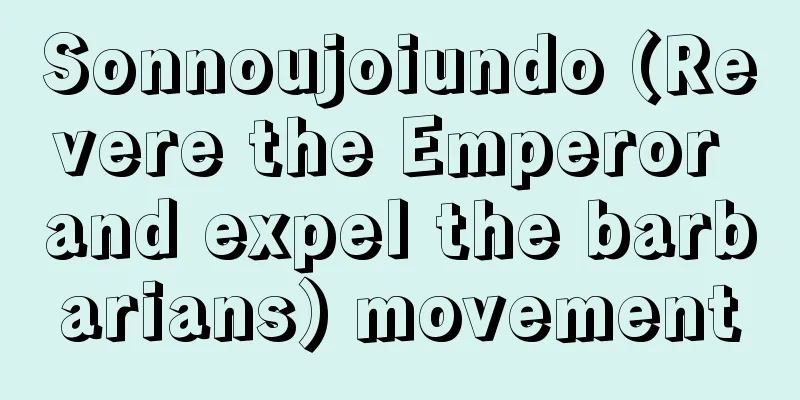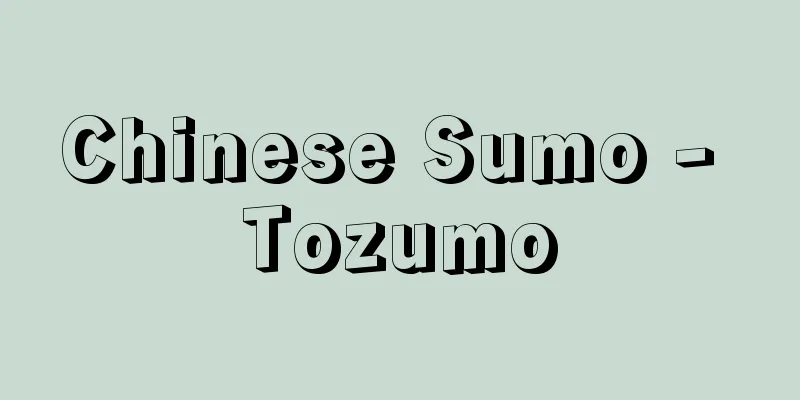Sonnoujoiundo (Revere the Emperor and expel the barbarians) movement

|
A political movement at the end of the Edo period that criticized and opposed the Edo Shogunate's foreign policy and autocratic system. [Shigeki Toyama] True personalityThe idea of revering the Emperor, which advocated respect for the traditional authority of the Emperor, who was at the top of the class system, and the idea of expelling foreigners, especially Western countries with cultures different from Eastern culture, as barbaric countries with inferior morals, and advocating their expulsion, were both feudal ideas that existed throughout the Edo period. However, the combination of these two ideas led to the development of a political movement that sought reform of the shogunate government and the establishment of a unified nation, which was a defining feature of the Sonno Joi theory of the late Edo period. During the Tenpo period in the 1840s, when peasant uprisings were occurring rapidly and the Oshio Heihachiro Rebellion was causing serious instability in the rule of the shogunate and the feudal domains, reports of the Opium Wars in China were spreading and foreign ships were arriving one after another, raising a sense of crisis over invasion by Western countries. Mitogaku, advocated by Confucian scholars such as Fujita Toko and Aizawa Seishisai under Tokugawa Nariaki, lord of the Mito domain, emphasized the idea of revering the emperor and expelling the barbarians as a way to overcome the impending crisis of internal and external troubles, and had a great ideological influence on the samurai class throughout the country. He argued that if the Shogun took the lead in demonstrating respect for the Emperor, the feudal lords, samurai, and people would respect and submit to the Shogun and the feudal lord, and he also sought to raise the morale of the samurai by making expulsion of foreigners the basic principle of foreign policy. In short, his goal was to restore the Shogunate and feudal domain system, and was not a political movement that went beyond that order. [Shigeki Toyama] Development into a reform movementIn 1853 (Kaei 6), the American envoy Perry arrived and demanded the opening of Japan to the rest of the world. Although the shogunate wanted to maintain its isolationist policy, it lacked the confidence to counter the military force of the American fleet, and was forced to conclude the Treaty of Peace and Amity the following year. This caused discontent among the samurai class throughout the country, and the anti-foreign theory became a driving force in driving them to take action in criticizing the shogunate. In the face of this imminent foreign crisis, even lower-ranking samurai who were not normally allowed to speak out about shogunate politics, opened the way to speech and insisted that talented people be appointed regardless of their family status. They also advocated reform of the shogunate and domain governments in order to strengthen the military to carry out the anti-foreign policy. The lower-ranking samurai, who felt the contradictions of the shogunate and domain system, used the idea of reverence for the emperor as a shield when they overstepped the constraints of order to make political statements and take political action. In 1858 (Ansei 5), the shogunate, having succumbed to the blackmail of the American Consul General Harris, decided to conclude a trade treaty and sought imperial sanction for the treaty from the Imperial Court in order to reconcile the opposing opinions on foreign affairs among the samurai class. In response, Tokugawa Nariaki and other daimyo, samurai and ronin who advocated expulsion of foreigners mobilized the nobles to work to block the imperial sanction. On the other hand, Shimazu Nariakira, the lord of the Satsuma domain, and Matsudaira Yoshinaga, the lord of the Echizen domain, who intended to reform the shogunate, tried to have Hitotsubashi Yoshinobu (the son of Nariaki) succeed the sickly Shogun Iesada, and also received an imperial decree to realize this, so they sent their trusted aides, Saigo Takamori and Hashimoto Sanai, to Kyoto to persuade the nobles. Thus, the emperor and the nobles became the focal point of political affairs. Seeing this situation, the chief advisor, Ii Naosuke (Lord of Hikone Domain), signed the Treaty of Amity and Commerce between the United States and Japan without imperial permission, selected Tokugawa Yoshitomi (Iemochi), Lord of Kishu Domain, as the successor to the shogunate, and carried out the Ansei Purge, punishing the pro-expulsion faction and daimyo, samurai, shogunate officials, ronin, and nobles who supported Hitotsubashi. As a result, the Sonno Joi movement, which opposed the opening of the country and blamed the chief advisor for disobeying the decree, became a movement that criticized the tyranny of the shogunate, and expanded to a nationwide scale, involving not only lower-ranking samurai of various domains, but also the children of goshi, landlords, and merchants. The sonno joi faction killed the elder Ii in 1860 (Man'en 1) (the Sakuradamon Gate Incident), attacked and injured the senior councilor Ando Nobumasa (Nobuyuki, Nobuyuki) in 1862 (Bunkyu 2) (the Sakashitamon Gate Incident), and further committed acts of terrorism against shogunate officials and pro-shogunate nobles' retainers in Kyoto, coming to dominate the political scene in Kyoto. The large outside domains of Satsuma, Choshu, and Tosa took advantage of this situation and, in order to strengthen their own domains' political influence, competed in campaigns to receive imperial decrees calling for the shogunate to reform the shogunate government or carry out expulsion of foreigners, and succeeded. In 1863 (Bunkyu 3), the anti-foreign faction of the Choshu clan allied with the noble Sanjo Sanetomi and others, and had an imperial edict issued urging the implementation of the expulsion of foreigners, and further plotted for the emperor to personally lead an expedition, i.e. for the emperor to take control of the military forces of the various clans, and even the restoration of the monarchy. However, Emperor Komei and the upper court nobles, while wishing to expel foreigners, were opposed to the overthrow of the shogunate, and allied with the Satsuma and Aizu clans to cause the August 18th Coup, expelling the Choshu clan soldiers and hard-line anti-foreign nobles from Kyoto. The experiences of the battle between the Satsuma Domain and the British fleet in 1863 (the Anglo-Satsuma War) and the battle the following year between the combined fleet of Britain, France, America, and the Netherlands and the Choshu Domain (the Shimonoseki bombardment incident of the combined fleet of Britain, France, America, and the Netherlands), made the anti-foreign faction realize that it was impossible to carry out the expulsion of foreigners immediately. Thus, the political movement that had adopted the banner of reverence for the Emperor and expulsion of foreigners was forced to change its character, both in terms of reverence for the Emperor and expulsion of foreigners. The movement to overthrow the shogunate was born out of this change. [Shigeki Toyama] "The Meiji Restoration" by Shigeki Toyama (1951, Iwanami Shoten) " "Modern Japanese History 1" by Kiyoshi Inoue (1951, University of Tokyo Press) [Reference] |Source: Shogakukan Encyclopedia Nipponica About Encyclopedia Nipponica Information | Legend |
|
江戸幕府の外交政策と専制体制を批判、反対した幕末の政治運動。 [遠山茂樹] 本来の性格身分制度の最頂点に位する天皇の伝統的権威の尊重を説く尊王思想、および自国を道徳文化の優れた中華(ちゅうか)として尊び、外国とくに東洋文化と異質の文化をもつ欧米諸国を道徳の劣った野蛮の国、夷狄(いてき)と卑しめ、その排撃を説く攘夷思想は、ともに封建思想であり、江戸時代を通じて存在した。しかしこの二つの思想が結合し、幕府政治の改革と統一国家の樹立を求める政治運動という性格をもつに至ったのが、幕末の尊王攘夷論の特色であった。百姓一揆(いっき)が激発し、大塩平八郎(おおしおへいはちろう)の乱が起こって、幕府と藩の支配の動揺が深刻となる一方、中国でのアヘン戦争の報道が伝わり、外国船の来航が相次いで、欧米諸国の侵略への危機感が高まった1840年代の天保(てんぽう)期に、水戸藩主徳川斉昭(とくがわなりあき)の下で、藤田東湖(ふじたとうこ)・会沢正志斎(あいざわせいしさい)らの儒学者が唱えた水戸学は、内憂外患の迫る危機を克服する方策として、尊王攘夷論を強調し、全国の武士層に大きな思想的影響を与えた。将軍が率先して天皇尊崇の実を示せば、大名・藩士・人民は将軍・大名を敬し服従するようになると説き、また攘夷を対外策の基本理念とすることにより、武士の志気を振起しようと図った。要するに幕藩制の立て直しを目的としたもので、その秩序を超える政治運動ではなかった。 [遠山茂樹] 改革運動への発展1853年(嘉永6)アメリカ使節ペリーが来航し開国を要求すると、幕府は、鎖国制度を維持したい本心をもちながら、アメリカ艦隊の武力に対抗する自信をもたないため、翌年やむなく日米和親条約を結んだ。これが全国の武士層の不満を巻き起こし、攘夷論は彼らを幕閣批判の行動へ駆り立てる力となった。本来幕府政治への発言を許されぬ下級藩士も、この対外危機の切迫に対し、言論の道を開き、家柄の高下にかかわりなく人材を登用せよと主張した。また攘夷実行の軍備充実のため、幕政・藩政を改革せよと説いた。幕藩制の矛盾を切実に感じていた下級武士が、秩序の制約を踏み越えて政治発言をし、政治行動を行う際、盾とした理念が尊王論であった。 1858年(安政5)、アメリカ総領事ハリスの強請に屈した幕府は、通商条約の締結を決意し、武士層内部の対立する対外意見を協調させるため、条約の勅許を朝廷に求めた。これに対し徳川斉昭をはじめ攘夷を主張する大名や藩士・浪人は、公卿(くぎょう)を動かし、勅許を阻止しようと働きかけた。他方で幕閣の改革を意図する薩摩(さつま)藩主島津斉彬(しまづなりあきら)、越前(えちぜん)藩主松平慶永(まつだいらよしなが)は、病弱の将軍家定(いえさだ)の跡継ぎに一橋慶喜(ひとつばしよしのぶ)(斉昭の子)をたてようと図り、これまた勅旨を得てその実現を図るべく、腹心の西郷隆盛(さいごうたかもり)・橋本左内(はしもとさない)を京都に派遣して、公卿を説いた。こうして天皇と公卿は、政局の焦点にたつこととなった。この情勢をみた大老井伊直弼(いいなおすけ)(彦根(ひこね)藩主)は、勅許なしに日米修好通商条約に調印し、将軍の跡継ぎを紀州藩主徳川慶福(よしとみ)(家茂(いえもち))に決定し、攘夷派・一橋擁立派の大名・藩士・幕臣・浪人と公卿を処罰する安政(あんせい)の大獄を断行した。このため、開国に反対し、大老の違勅の罪を責める尊王攘夷運動は、幕閣の専制を非難する運動となり、諸藩の下級藩士だけでなく、郷士・地主・商人の子弟までも巻き込む全国的な規模に拡大した。尊王攘夷派は、1860年(万延1)井伊大老を殺し(桜田門外の変)、1862年(文久2)には老中安藤信正(あんどうのぶまさ)(信睦(のぶゆき)、信行)を襲って負傷させ(坂下門外の変)、さらに京都で幕吏や佐幕派公卿の家臣にテロ行為を加え、京都政局を支配するまでになった。薩摩・長州・土佐の外様(とざま)大藩は、この情況を利用し、自藩の政治発言力を強めるために、幕政改革ないし攘夷実行を幕府に求める勅旨を申し受ける運動を競い合い成功した。 1863年(文久3)長州藩攘夷派は、公卿三条実美(さんじょうさねとみ)らと結び、攘夷実行を迫る勅諚(ちょくじょう)を出させ、さらに天皇の親征、すなわち天皇の諸藩軍隊指揮権の掌握、さらには王政復古をもくろんだ。しかし孝明(こうめい)天皇や上層公卿は、攘夷は希望するが倒幕には反対であり、薩摩藩、会津藩と結んで、八月十八日の政変を起こし、長州藩兵と攘夷強硬派の公卿を京都から追放した。1863年の薩摩藩とイギリス艦隊との戦い(薩英戦争)、翌年のイギリス、フランス、アメリカ、オランダの四国連合艦隊と長州藩との戦い(四国連合艦隊下関(しものせき)砲撃事件)の経験によって、攘夷派は、攘夷即時実行の不可能を悟った。ここに尊王と攘夷を旗印とする政治運動は、尊王の面でも攘夷の面でも、その性格を転換せざるをえなくなった。討幕運動はその転換のなかから生まれた。 [遠山茂樹] 『遠山茂樹著『明治維新』(1951・岩波書店)』▽『井上清著『日本現代史1』(1951・東京大学出版会)』 [参照項目] |出典 小学館 日本大百科全書(ニッポニカ)日本大百科全書(ニッポニカ)について 情報 | 凡例 |
<<: Respect for the Emperor - Sonnoron
Recommend
Zenkyoto Movement - Zenkyoto Movement
Zenkyoto is an abbreviation of the All-Gaku Joint ...
Colorful painting of old Imari
…In 1659, the East India Company ordered over 57,...
Business report - Eigyohokokusho
This is a document prepared by a company at each ...
Red vermilion Yangcheng - Tsuishuyouzei
This is the hereditary name of a family that pass...
Heawood, PJ (English spelling) HeawoodPJ
…Since then, the four-color problem has attracted...
Dipsacus fullonum (English spelling) Dipsacusfullonum
…[Mr. Makoto Fukuoka]. … *Some of the terminology...
incombustible moss
…The scientific name antipyretica , which means “...
Ymir
…To the north of the mouth of the abyss is Niflhe...
Kearney, P. - Kearney
…Irish author. Nephew of Peadar Kearney, the auth...
Cross-match test (cross-match test)
This test is performed to prevent adverse reaction...
Karaism - Karai is (English spelling) Karaism
A sect of Judaism. Its origin is the Hebrew word q...
Bath sponge - Bath sponge
A sponge of the family Porphyridae in the class De...
Honen
Year of death: 25th January 1212 (29th February 12...
Zou Yan
Date of birth and death unknown. A Chinese thinke...
Yerevan (English spelling) Ереван/Erevan
The capital of the Republic of Armenia. Populatio...









